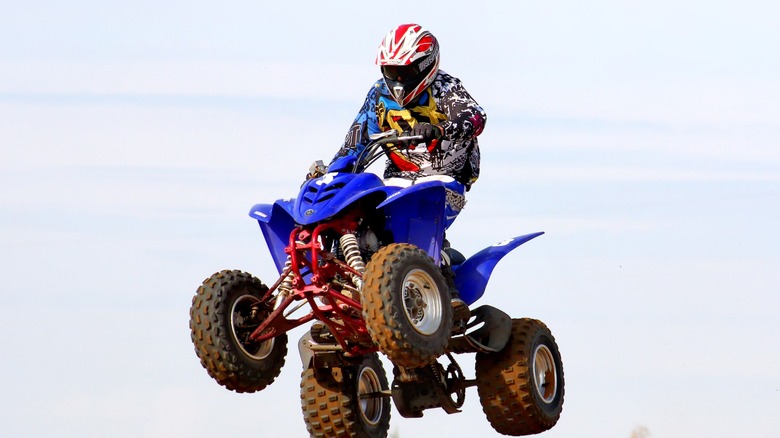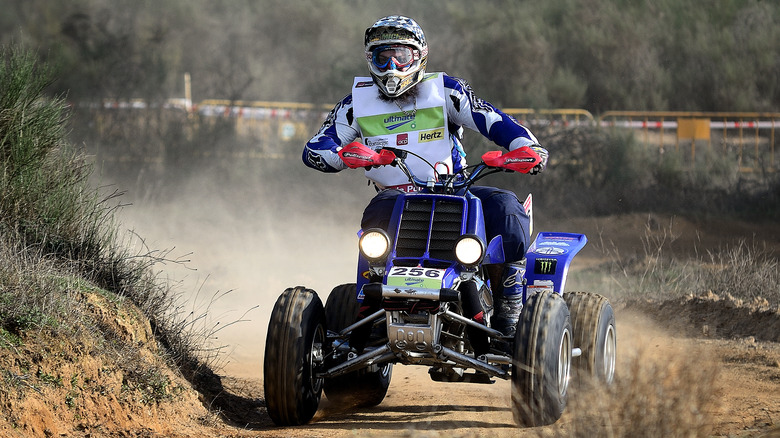5 Discontinued Yamaha ATVs That Deserve A Second Chance
Yamaha wasn't the first to bring the ATV to the U.S.; that honor belongs to the banned Honda ATC. But in 1980, Yamaha launched the YT125 Tri-Moto, which had three wheels powered by a 123cc two-stroke engine. Since then, the Japanese power sports company has steadily released a variety of all-terrain vehicles for over 40 years. Its current lineup consists of the Grizzly, Kodiak, Raptor, YFZ450, and youth YFZ50. According to MarketsandMarkets.com, the ATV market is projected to achieve $3.3 billion in 2030, with utility quads leading in popularity.
However, there are certain models from the past that all-terrain enthusiasts hold in high esteem and would love to see make a return. These ATVs offered things like simplicity, utility, reliability, and unrestrained power, leaving a lasting impression on the industry. Sadly, the only way to ride the following Yamaha all-terrain vehicles is to find them on the used market. But perhaps these classic machines could resurface one day, hopefully with their original spirit intact.
The Yamaha Banshee 350
The late 80s saw the release of one of the most successful Yamaha ATVs in history, the Banshee. What made this model special was its explosive power, which overshadowed other less robust options on the market. Its design was unique because Yamaha modified an RZ 350 motorcycle engine to power the Banshee, and it was quick. At the time of release, this ATV had the largest two-stroke engine ever put in a quad. The Banshee leveraged all its 350ccs to win the Baja 1000 race in its first time competing.
Many claim this classic ATV is one of the best choices for conquering sand dunes. One rider explained, "they are fun as hell.... nothing better than a twin cylinder 350cc 2 stroke quad that makes you hold on when you punch the throttle." Another enthusiast stated, "Banshees are still the king of the dunes as ATV's go. Even with all these other new quads out the shee still stands its ground." The Banshee 350 performs well on the sand due to its very noticeable powerband that kicks in during acceleration. One rider noted, "A stock Banshee, for example, has a very peaky powerband with little power being made at low RPMs and a lot of power being made in the mid-range and top end of the RPM range."
The Yamaha Blaster 200 (YFS200)
Released in 1988, the Blaster featured a 195cc 2-stroke engine and has garnered more sales worldwide than any other ATV with less than 250ccs. This model is remembered fondly for its straightforward and uncomplicated design. Considered a great option for new riders, the Blaster 200 was robust enough to provide thrills but not potent enough to be intimidating to newcomers. One rider commenting on the approachability of the Blaster for beginners noted, "They're 2-stroke but some come with a mixer so you don't even have to mix the gas yourself."
The other advantage this quad had was its lightweight and small design, which made it easier to maneuver than larger models. Unfortunately, both the Banshee and the Blaster shared the same fate in 2006, when they were discontinued due to stricter emissions and noise requirements. Yamaha would opt for a change from 2-stroke to the more efficient 4-stroke engines for its ATVs going forward.
The Yamaha Warrior
The Warrior was also released in the late 80s and offered a 4-stroke 348cc engine with a sport quad industry first, an electric starter. This ATV provided a potent mid-range punch and was still maneuverable enough to be manageable in a variety of conditions. One owner stated, "I can go from hard pack, to a swamp hole, to sand, to pavement and it takes them all very well." Although one quad enthusiast did point out, "the only reason I would not recommend the Warrior is [if] you are going to do strictly dune riding."
This classic quad also featured a low center of gravity due to its design. The enhanced stability of this ATV meant it was more difficult to flip over and felt more solid at higher speeds. The Warrior was phased out in the early 2000s to make way for the surprisingly fast Yamaha Raptor 700R with an impressive top speed.
The Yamaha Tri-Z 250
This three-wheeled ATV launched in 1985 and came packed with a 250cc 2-stroke engine. The Tri-Z 250 was Yamaha's answer to the widely popular Honda ATC. But, while three-wheeled vehicles tended to have issues tipping over, Yamaha's model offered excellent handling. One of the reasons the Tri-Z 250 was more stable had to due with where the gas tank was located. Yamaha placed the tank as low into the frame as they could, creating an exceptionally low center of gravity. This ATV is also a good option for those riders who feel cramped on other machines. One owner explained, "The Tri-Z is a great trike, especially if you are a taller guy. Just seems to have more room to move compared to the R or Tecate or even a 350X."
Unfortunately, due to mounting injuries, there were calls for the major manufacturers to stop producing three-wheeled vehicles for sale in the U.S. So, in 1988, Yamaha and others in the industry agreed to step away from vehicles like the Tri-Z 250. Unfortunately, Yamaha only produces quads today, so if you want to experience this trike, you'll have to find one on the used market.
The Yamaha Pro Hauler
This strange vehicle straddled the middle ground between being a quad and a UTV. The rear bed and front racks can handle up to 466 pounds, and it can tow as much as 800 pounds. It features a 229cc 4-stroke engine and a large 13-liter (3.4 gallon) fuel tank. Nowadays you can choose either a UTV or a utility ATV, but nothing like the Pro Hauler is currently available. Unlike the other sport machines on this list, this Yamaha is built for working, loading, and hauling projects.
In addition to its unique design, the Pro Hauler is known for its lasting performance. One owner explained, "Them ol pro-haulers are pretty [tough], one [lasted] 13 years on my uncles farm." Unfortunately, these classic ATVs are rare and a challenge to get ahold of. One rider with a Pro Hauler stated, "I have one that took me a long time to find." While UTVs provide a similar function with more seats, it would be interesting to see this odd ATV return to Yamaha's lineup.





